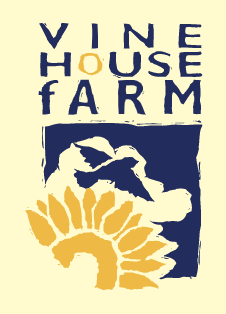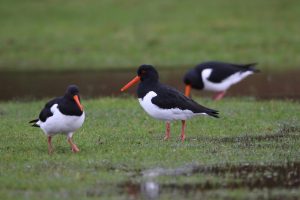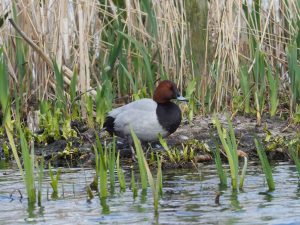
September has been an average month for warmth, even though we’ve had two spells when the temperatures rose to 25°C or 26°C. With only 29.4 mm of rain falling however, it is well below the average of 45mm.

September has been a good month for us weather wise, but we are still counting the cost of the August gales. They laid a lot of millet, broke barley ears off and even laid some of the sunflowers – something we’ve never seen before. When a crop has been laid by wind and rain, the yield suffers. The millet yield was probably only half of what it should have been.
The good weather was ideal for harvesting the millet, quinoa and the clover, but not so good for harvesting the potatoes. If the soil gets dry, it falls through the webs of the potato harvester and then the potatoes are falling from one web to another without any soil to cushion them, meaning that they then get bruised. A bruise on a potato is a black patch under the skin about the size of a blackberry. If we put too many bruises on potatoes, it reduces their value, sometimes by 50%. The answer was to irrigate the fields, so the soil did not fall through the webs on the picker so readily.
Last year we bought a three-row potato picker. We’d been using our two-row picker for eight years and it was becoming unreliable. When the picker breaks down it probably costs us £500 an hour because the grading team, tractors and trailers will be stood while the picker is being mended.
We had the option of buying another two-row machine or a self-propelled one, either would have been made in Germany. By self-propelled, I mean one that has its own engine and the driver sits on the potato picker. Generally a two-row self propelled picker gets more done than a two-row picker pulled by a tractor. We bought a British made three-row picker – which harvests three rows just as quickly as harvesting two rows. We’ve also had to buy a bigger tractor and the picker is not quite so easy to move on public roads as it is 4.2m/14 feet wide, but we are very pleased with it.
Our oil seed rape crops have not been a profitable crop these last two years, as they have has been ravaged by cabbage stem flea beetles. Many farmers have not planted oil seed rape this autumn because they have made a loss on the crop. We have planted a reduced area this year and, so far, the cabbage stem flea beetle has not been around in sufficient numbers to affect the plants.
Our oil seed rape seed used to be treated with a neonicotinoid chemical, the seed is tiny but the coating protected the plant from the cabbage stem flea beetle for at least eight months, by which time each plant was at least four feet high. It just shows how potent some of the chemicals are that we used.
We’d been using neonics since the 1990s. In 2008, a chemical was accidentally released into the air in Germany, killing all the bees in the surrounding area. This raised alarm bells and scientists then began working on the effects of neonicotinoids and by 2017 this chemical was being banned in Europe on some crops and by 2019 it was banned on all of our crops. No wonder our spraying machines have to have an MOT every year and our spray men have to go through courses and be tested every year. It’s still widely used in the USA because President Trump has reversed the ban on it and can be used on your pets to get rid of fleas.


Many years ago I found bird watching a bit aimless, so when the BTO were looking for volunteers to count birds on the Wash and the Lincolnshire bird club wanted volunteers to survey Lincolnshire, I volunteered. I count birds, put it all on a form and send that form away but I always keep a copy. Some of the surveys are quite specialised, in that I detect most of the birds I see by their song or call. By doing surveys over the same ground year after year, I can see declines and increases in populations and very often can work out why they are declining and so learn more about birds.
There are some quite simple surveys, the Garden Bird Watch is one that could well appeal to many of you. Record the birds in your garden, you can also record butterflies, mammals and reptiles, and every week fill in a form online. To find out more about it, search for
BTO. Garden Bird Watch, you can then catch up with what is happening in other peoples gardens.
All the Swallows that were breeding around here had left by September 10th, they keep leaving earlier and earlier. We have seen a few migrating Swallows since then. I have just been to Aberdeenshire for a few days and there were Swallows around up until September 27th when I left. Farming in Aberdeenshire is not so intensive as around here. Most farmers also have cattle and there are burns running through the countryside with steep sides, that are too steep to farm, so there is ground that is not grazed or sprayed.
Not so here in the Fens, where the only places that are left for wildlife are redundant boundary dykes, separating one farm from another farm that are not required for drainage, or where a farmer is doing some conservation. There are less farmers in conservation schemes than there were as the government has made it more difficult for farmers to enter such schemes. The money has gone elsewhere, to the NHS for example or even to third world countries.
No doubt many of you saw the David Attenborough program around the middle of September highlighting the worldwide plight of wildlife. He ended the programme by saying “What happens now is up to us”. We could write to our MPs to tell Boris to go and see Sir David, and ask him what would he like us to do. Having said that, the real problem is that there are too many of us on this planet. Forests and vegetation worldwide is getting chopped down, in many cases just so people can make a living, then there are also big farming companies that are clearing thousands of acres to grow soya beans and maize.
There are two other ‘crops’ that I haven’t mentioned – one is our most recent flock of free range hens, that started laying eggs at the end of October last year. They have been laying at 90% for more than six months, which means 9 out of 10 chickens lay an egg a day. We shall be keeping them until early January, then they go away to make chicken pies or chicken soup, and we will then give their house a good spring clean before getting the next flock in.
The other ‘crop’ is our solar panels. All our crops rely on sunshine – technology has moved on and we can convert sunshine into electricity and get a crop from the roofs of our buildings. March, April and May were excellent months for our panels, they continue to work whenever the sun shines.
Due to the current situation the Lincolnshire Wildlife Trust will not be holding the usual indoor meetings before Christmas at Pinchbeck
Our 2021 calendar will be available this month – it doesn’t include next year’s farm walk dates as we don’t know what the restrictions will be next year



